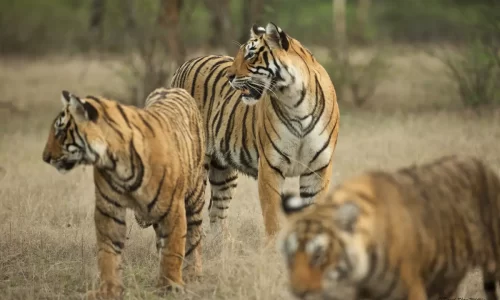Tigers are among the most iconic and powerful animals on the planet. Known for their strength, agility, and beauty, they are also symbols of conservation efforts due to their endangered status. Among the various subspecies of tigers, two stand out: the Siberian tiger (Panthera tigris altaica) and the Royal Bengal tiger (Panthera tigris tigris). These two majestic creatures, while closely related, have distinct differences in terms of appearance, habitat, behavior, and conservation status.
Physical Characteristics of Siberian Tiger vs Royal Bengal Tiger
One of the most notable differences between the Siberian and Royal Bengal tigers is their size. The Siberian tiger is the largest of all tiger subspecies, with males reaching up to 12 feet in length, including their tail, and weighing as much as 800 pounds. Their robust body and thick fur are well-suited to survive the harsh, cold environments of Siberia, where temperatures can plunge well below freezing.
In contrast, the Royal Bengal tiger is slightly smaller, with males typically weighing between 400 to 500 pounds and measuring around 9 to 10 feet in length. While the Bengal tiger is still a large and powerful animal, its size is more suited for the tropical forests and dense jungles of India and surrounding countries.
Another striking difference is in their coat color. The Siberian tiger has a paler, more muted orange coat with broader black stripes. This coloration helps it blend into the snow-covered landscapes of its habitat, offering a form of camouflage. The Royal Bengal tiger, on the other hand, has a more vibrant orange coat with darker and sharper stripes, allowing it to blend into the dense undergrowth and lush vegetation of the Indian subcontinent.
Habitat and Distribution
The Siberian tiger is found primarily in the Russian Far East, particularly in the Sikhote-Alin mountain range, with some parts of China also hosting these magnificent creatures. Their range is limited by the cold, harsh environment, and they are most commonly seen in temperate forests, which offer both food and shelter. Siberian tigers are solitary and territorial, with large home ranges that can stretch up to 1,000 square miles in some cases. The thick forests, snow, and sparse human population make the Siberian tiger well-adapted to this rugged terrain.
In contrast, the Royal Bengal tiger is predominantly found in the forests, grasslands, and wetlands of India, Bangladesh, Bhutan, and Nepal. The Bengal tiger’s habitat is characterized by dense vegetation, wetlands, and riverine ecosystems, all of which offer the perfect environment for hunting and surviving. Bengal tigers are also solitary creatures but have a more varied range in terms of their environmental preferences, from the hot, humid plains to the cooler highlands.
Behavior and Diet
Both Siberian and Royal Bengal tigers are apex predators and play crucial roles in their respective ecosystems. Their diet mainly consists of large herbivores such as deer, and wild boar, and sometimes even larger prey like elk and sambar. Siberian tigers, due to their larger size and strength, can take down animals like moose and roe deer, while Royal Bengal tigers are more likely to hunt smaller, medium-sized animals but have been known to take down buffalo and even young elephants when the opportunity arises.
Tigers are ambush predators, relying on their stealth and power to close in on their prey and launch a surprise attack. Siberian tigers, with their larger size and strength, often rely on brute force, while Royal Bengal tigers make use of their agility and speed in the thick underbrush to surprise their prey.
Conservation Status
Both the Siberian and Royal Bengal tiger face serious threats to their survival. The Siberian tiger is critically endangered, with only around 500 individuals remaining in the wild. Habitat loss, poaching for their pelts, bones, and other body parts, and human-wildlife conflict are the primary reasons for their declining numbers. Conservation efforts in Russia, including anti-poaching laws and habitat restoration projects, have shown some success, but the population remains at risk.
The Royal Bengal tiger, while still classified as endangered, has a larger population of around 2,000 individuals in the wild. The main threats to this subspecies are habitat loss, poaching, and the loss of prey species. India’s government and various NGOs have made concerted efforts to protect the Bengal tiger, particularly through the establishment of tiger reserves and the implementation of more robust anti-poaching measures.
The Future of These Tigers
Both the Siberian and Royal Bengal tigers are integral parts of their ecosystems, and their decline would have profound effects on the biodiversity of their respective habitats. We must continue to focus on tiger conservation efforts to ensure that future generations can experience these magnificent creatures in the wild. With increased awareness, international cooperation, and sustainable wildlife management, there is hope for both the Siberian and Royal Bengal tigers.
In conclusion, while the Siberian and Royal Bengal tigers differ in size, appearance, and habitat, they share a common plight. Both are incredible animals that deserve our attention and protection. The battle for their survival cannot be won by any single effort but requires global cooperation and dedication to preserving the natural world.




